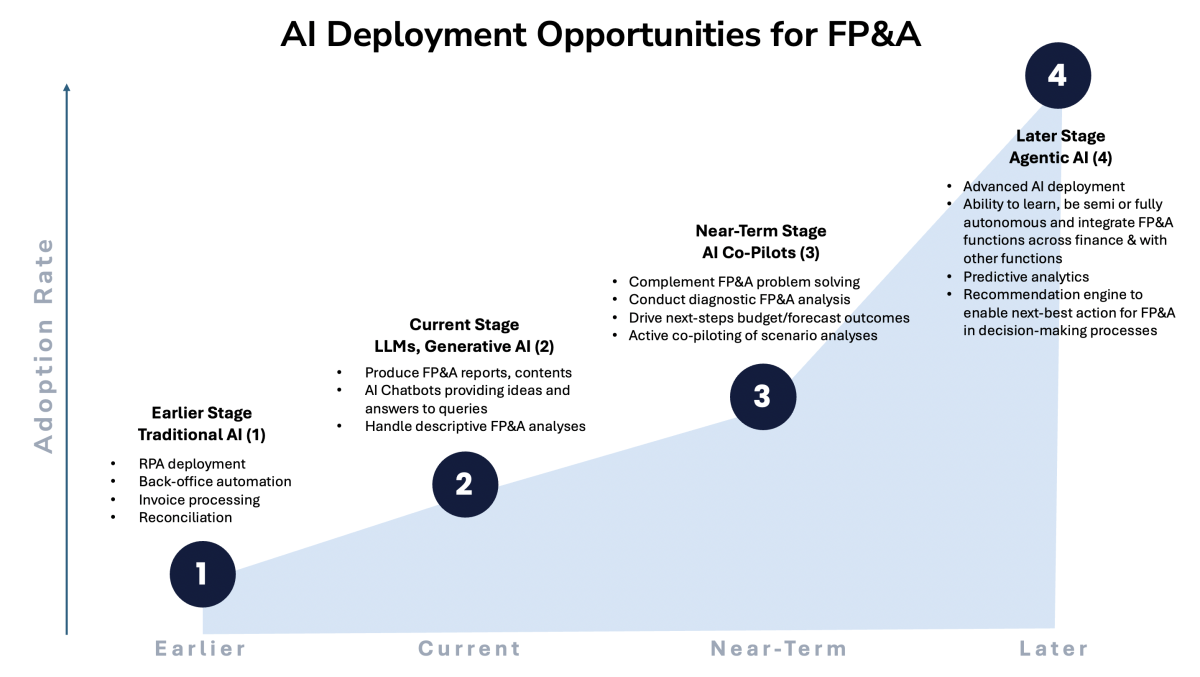In this article, the author explains how Artificial Intelligence (AI) can help FP&A professionals become invaluable...

Over the past year, we've seen impressive strides in AI technologies. These innovations are becoming increasingly accessible due to the commercialisation of AI models, sparking a wave of transformative applications and pilots poised for broader commercial rollouts made available to FP&A.
The Present Landscape of FP&A Technology
FP&A leaders are increasingly eyeing AI-powered tools to boost productivity and tackle the key challenges highlighted in the 2024 FP&A Trends Survey [1].
The survey revealed that 35% of organisations struggle with data quality and timeliness, with nearly half spending significant time consolidating data from multiple sources. Scenario Planning remains tough for 21% of respondents amid uncertain business conditions, and despite growing demands, 57% still need 1-3 months to complete annual budgets. Just 13% have a truly integrated approach to management planning, signalling a gap between strategy and execution. Meanwhile, only 35% of FP&A time is focused on generating insights, with 45% still tied up in data collection and validation.
The FP&A community has made strides in technology adoption, with 40% of companies investing in cloud-based ERP systems and integrated platforms, according to the 2024 FP&A Trends Survey. Yet, old habits die hard — 52% of organisations still rely on basic tools like Excel, and only 18% have transitioned to modern cloud-based solutions.
While FP&A leaders are keen to implement technologies that enhance insights, streamline planning and boost business partnerships, many still face technological and adoption hurdles.
Current tools often fail to support integrated data-driven actions, focusing more on record-keeping and reporting than driving collaboration. This gap makes it challenging to communicate complex financial insights effectively and align them with business needs.
AI technology can be a game-changer in addressing these pain points.
AI Deployment Opportunities for FP&A
The 2024 FP&A Trends Survey shows a mixed outlook on AI adoption: while 44% of companies plan to implement AI within the next six months, 35% remain sceptical about its value in FP&A processes. This hesitation is unsurprising, considering how reliable advanced end-user AI technology is perceived to be due to ongoing concerns about output quality and a general lack of awareness of how AI can be deployed practically.
As AI technology evolves, we'll likely see a hockey-stick growth pattern in adoption — each development stage opening new opportunities to enhance FP&A practices. AI adoption in FP&A will evolve through these distinct stages.
1. Earlier Stage — Traditional AI: Technologies like Robotic Process Automation (RPA) have been used for back-office tasks like invoice processing and fraud detection. However, they are configured for defined, linear workflows and are rigid by design.
2. Current Stage — LLMs and Generative AI: Today, Large Language Models (LLMs) and Generative AI enhance tasks like research and report generation, leveraging Machine Learning and retrieval-augmented generation (RAG) to create contextual financial content and basic analyses.
3. Near-Term Stage — AI Copilots: Soon, AI-driven copilot assistants will blend traditional AI with natural language LLMs and Generative AI to further improve the user experience, complementing FP&A and providing proactive guidance on multi-step FP&A processes.
4. Later Stage — Agentic AI: Agentic AI is still in the prototype stage. It will autonomously perform tasks and make decisions based on data inputs and learning algorithms. For FP&A, this could automate complex tasks like Scenario Planning and Predictive Analytics to offer the next-best recommendations on actionable outcomes.

Figure 1: AI Deployment Opportunities for FP&A (Source: Andrew Wee)
The current and near-term stages present the best opportunities for FP&A professionals to deploy reliable AI solutions. Successfully implementing these phases will pave the way for more advanced AI applications in the future and later stages, positioning FP&A as a strategic business partner.
Practical Current and Near-Term AI Adoption
Use Case 1: FP&A Knowledge Management
Challenge: Knowledge management has been a constant challenge for FP&A teams. With limited time, resources and staff turnover, many companies struggle to properly organise, use and share critical knowledge, such as FP&A policies, internal and external standards and other essential documentation. This issue is especially pronounced during the onboarding new team members or handover situations, where quick access to accurate information and ensuring knowledge retention are vital.
AI Solution: A practical solution for FP&A teams is the deployment of intelligent AI chatbots powered by LLMs and RAG technology. These chatbots can provide instant, reliable answers based on customisable knowledge bases, including internal and public resources. Unlike generic LLMs, FP&A-specific chatbots are trained on tailored content, ensuring more accurate and relevant responses to financial queries.
For example, AI chatbots specialising in areas like IFRS, ethics and tax legislation, have been made available for commercial adoption, allowing users to quickly access precise answers to technical accounting, audit and tax-related questions. These chatbots can also assist with complex research by analysing financial documents securely stored for easy retrieval.
Examples: FP&A teams can deploy such AI chatbots tailored for them, enabling teams to ask queries in natural language like, "How will reclassifying Customer Service costs affect gross margins for our new products?" or "How do we apply Percentage of Completion accounting under IFRS?" Customised finance AI chatbots will be able to provide up-to-date, accurate responses to these questions, helping teams efficiently handle complex queries and improve performance while supporting broader business goals with precise financial knowledge.
Use Case 2: Generative AI for Automated Report Generation
Challenge: Traditionally, FP&A teams manually consolidate data from various systems — ERP, CRM and spreadsheets — into standardised templates, followed by drafting MD&A or periodic business review commentaries. This manual process is not only time-consuming but also lacks the agility needed to cater for different reporting needs while maintaining consistent reporting standards. Despite the introduction of finance dashboards and reporting tools, the lack of integrated features across reporting tools and systems continues to be a significant challenge, causing FP&A professionals to spend excessive time on data extraction, data cleansing and endless report formatting.
AI Solution: Generative AI can significantly ease resource and time constraints in helping FP&A with automated report generation. By leveraging Generative AI, FP&A teams can automate the creation of financial reports and narratives, all in a fraction of the time traditionally required. This shift frees up FP&A professionals to move from repetitive tasks like manual data consolidation and report formatting to more strategic activities that create business value.
By adopting Generative AI, FP&A teams can boost productivity, reduce manual workloads and focus more on strategic decision-making. Early finance adopters of Generative AI for such purposes as Moody's [2] have reported that users process up to 60% more report volumes while reducing task completion times by 30%.
Standalone LLM add-ons, such as ChatGPT Canvas, are already helping FP&A professionals interact with data using natural language features, generating macros and code for platforms like Google Colab or Excel to create data visualisations and reports.
At a wider enterprise application level, more finance platforms are integrating Generative AI capabilities into their existing solutions, transforming FP&A reporting while supporting confidentiality and compliance by using secured, private data. This integration enables automated, seamless workflows that embed AI directly into daily FP&A tasks. By incorporating Generative AI into core workstreams, organisations can streamline reporting, enhance data analysis and automate routine processes. This reduces manual intervention, speeds up reporting and unlocks new levels of efficiency across FP&A functions.
A notable example of this integration is the launch of Generative AI platforms in the industry designed to automate key FP&A functions and financial reporting. This platform features prompts that can automatically generate Management Discussion & Analysis (MD&A) reports, assist with earnings call preparations, analyse transcripts and reports and even produce anticipated Q&A sessions based on existing financial data. The predefined prompts guide the Generative AI engine to produce tailored outputs, offering highly specific and secure results that meet the unique needs of the FP&A function.
We are seeing the rapid development of Generative AI assistants for FP&A teams to produce tailored summaries, insights and storyboards.
Key Takeaways
AI is often hailed as the future, but its adoption hasn't been as fast as expected. Many FP&A teams are still navigating concerns around output quality, expertise gaps and data privacy.
Right now, FP&A professionals are experimenting with end-user AI tools, figuring out what works and setting the stage for broader adoption. I have shared in this article some of the LLMs and Generative AI tools that are being adopted by FP&A. Looking ahead, the real game-changers will be specialised AI copilots and Agentic AI applications designed specifically for FP&A tasks — a topic for another article.
To get ready, leaders should start small — think Generative AI — and gradually build up to more advanced tools. Just as important is investing in talent, whether through hiring or upskilling in AI and data analytics. With a clear vision and a willingness to adapt, FP&A leaders can stay ahead of the curve and drive lasting success for their organisations.
References:
- FP&A Trends Survey 2024: Empowering Decisions with Data: How FP&A Supports Organisations in Uncertainty - https://fpa-trends.com/fp-research/fpa-trends-survey-2024-empowering-decisions-data-how-fpa-supports-organisations
- How Moody's Gen AI Tool Cuts Financial Analysis Time by 30%, by Louis Thompsett, February 2025 - https://fintechmagazine.com/articles/how-moodys-genai-tool-cuts-financial-analysis-time-by-30
Subscribe to
FP&A Trends Digest

We will regularly update you on the latest trends and developments in FP&A. Take the opportunity to have articles written by finance thought leaders delivered directly to your inbox; watch compelling webinars; connect with like-minded professionals; and become a part of our global community.






